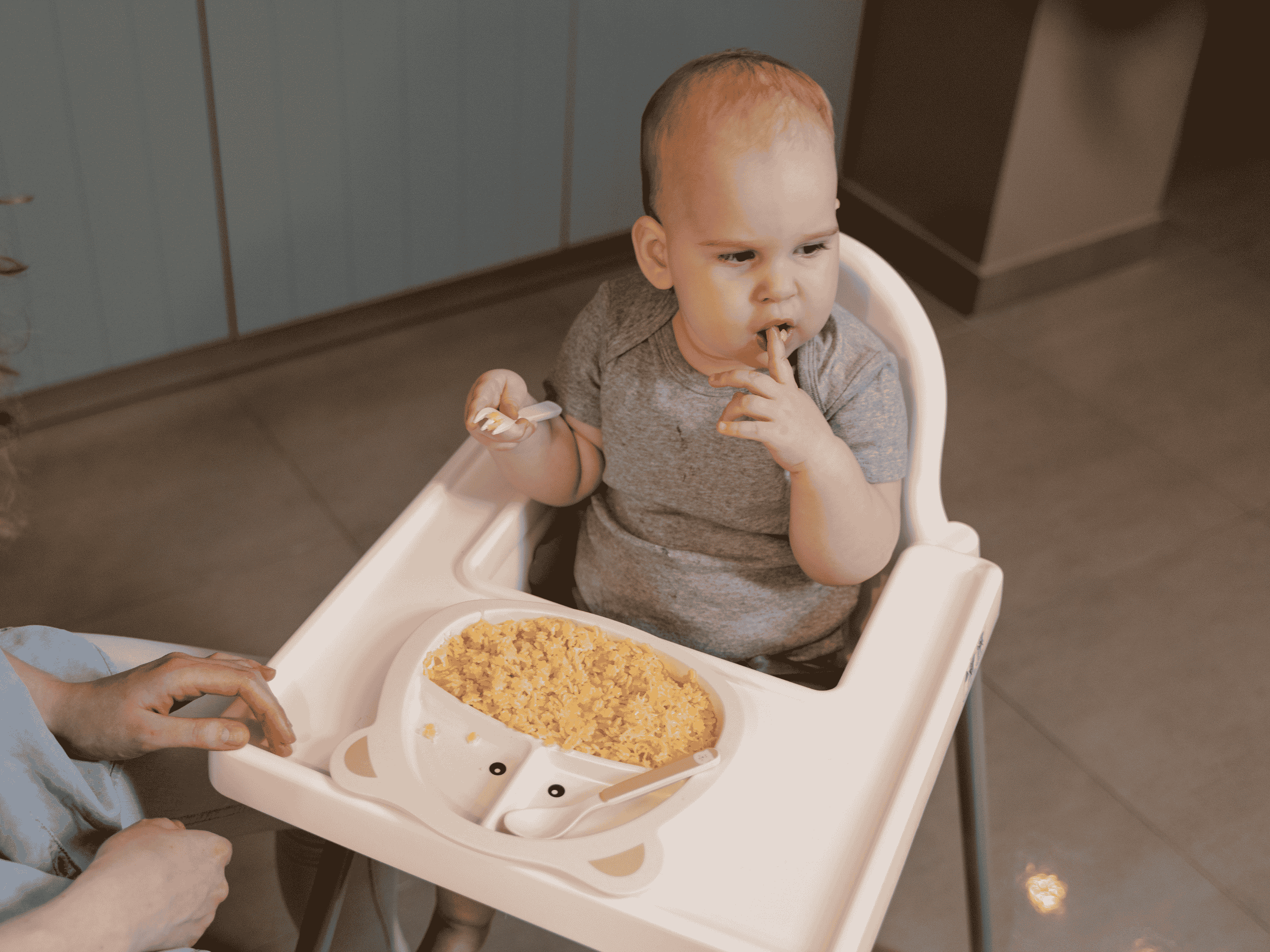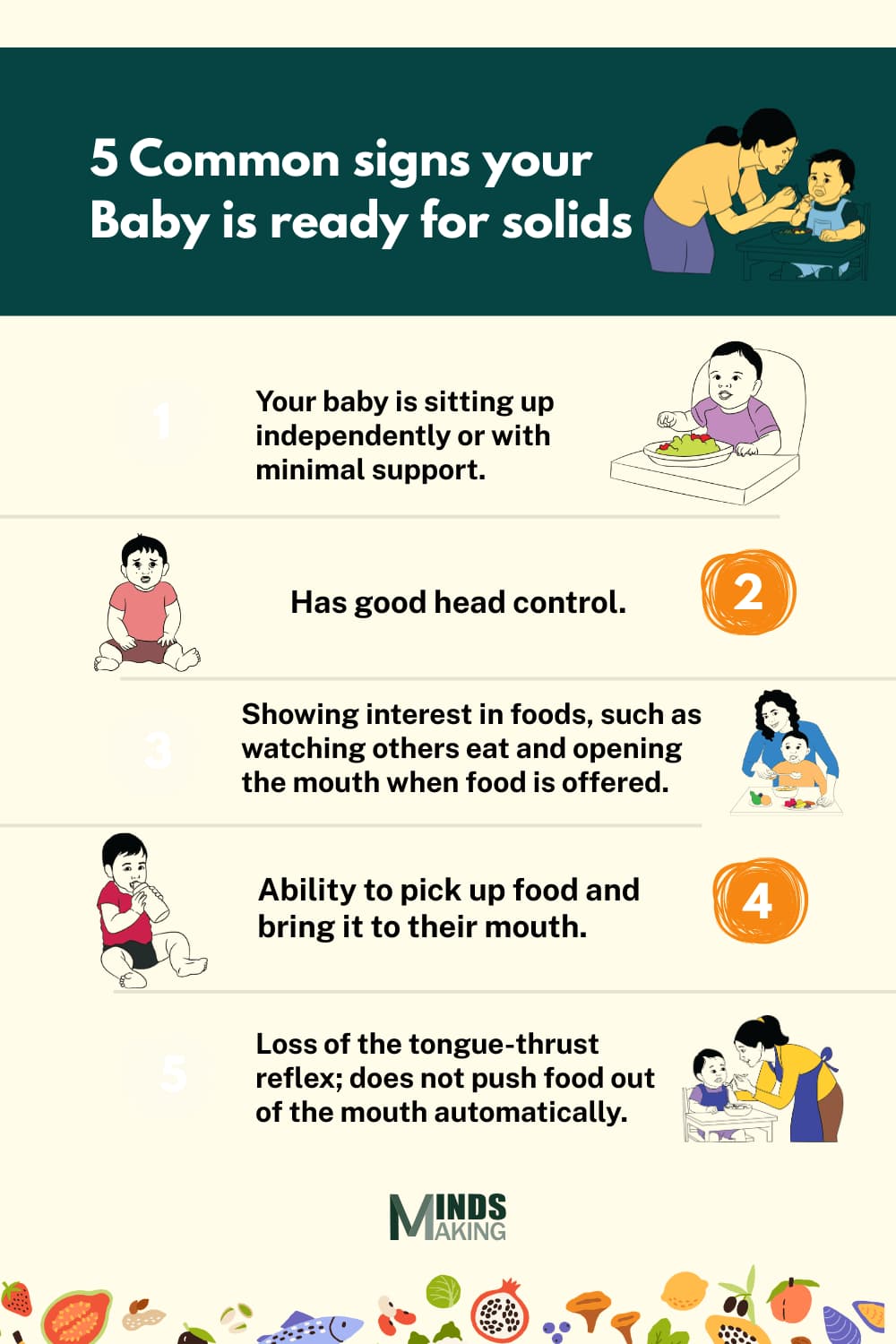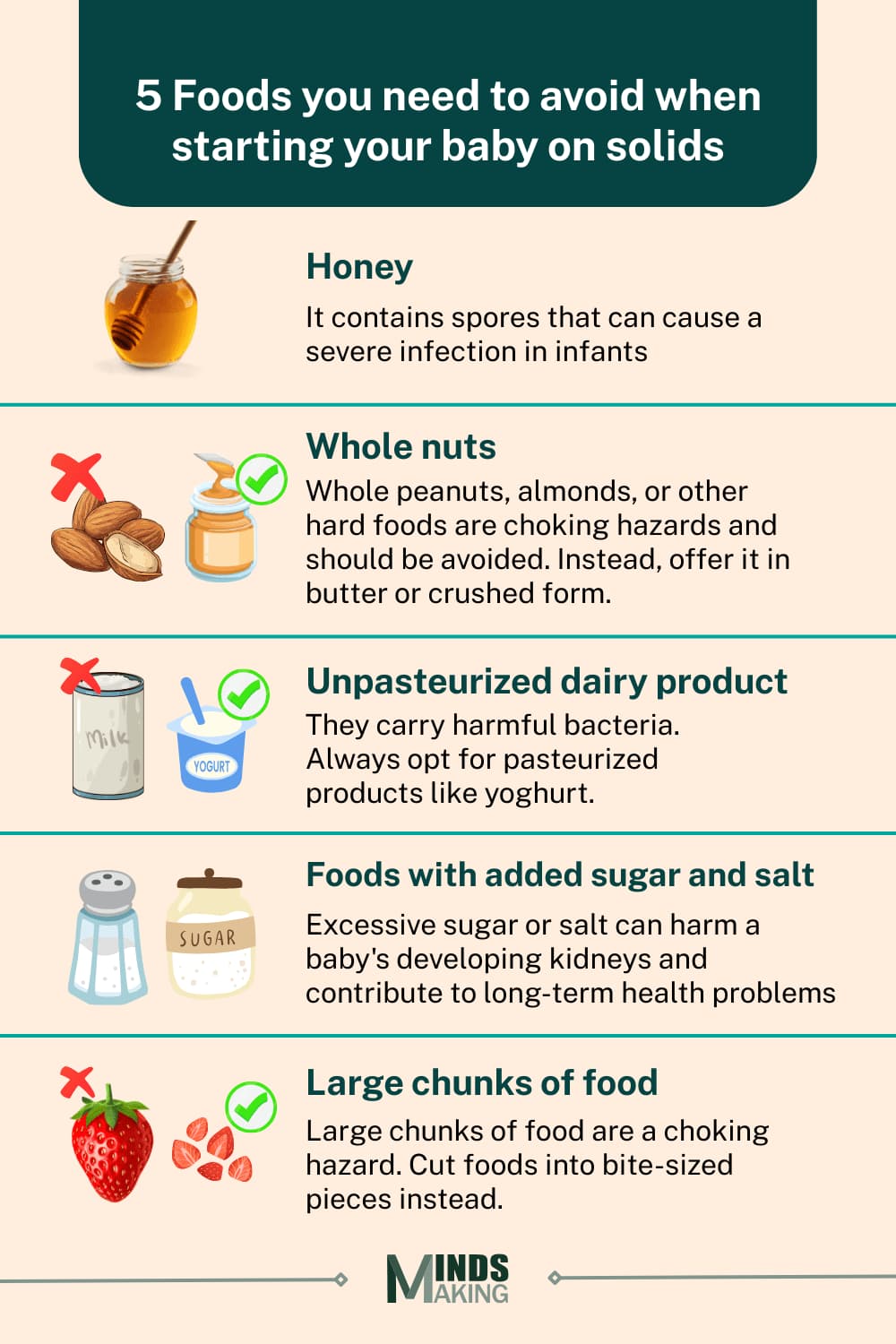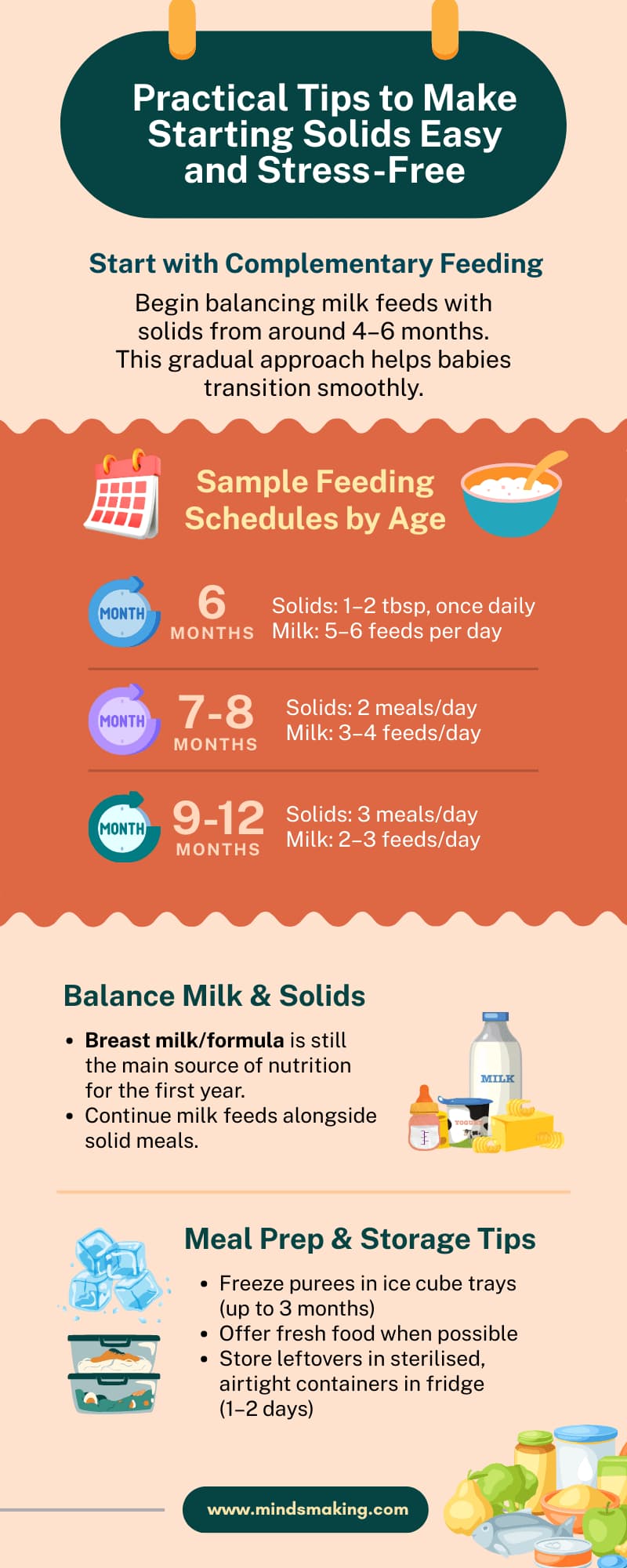Starting Solids
Pexel

Written by Mindsmaking Medical Writer
Fact Checked by Mindsmaking Professionals
4th, August, 2025
Wondering when and how to start solids for your baby? Learn the expert-backed benefits of complementary feeding, how it supports healthy growth, and why timing matters. Here are the signs that show your baby is ready for their very first bite!
Determining the right time for starting solids in babies is an important time in infant milestone development, yet it remains a widely debated issue. A study reveals that introducing solids before 4 months could lead to gastrointestinal issues, while a delayed introduction beyond 6 months could lead to micronutrient deficiencies (13). This shows the importance of finding the right window to start solids in babies.
As parents, you might often have thoughts on your baby’s readiness to start solids, what foods to introduce, the quantity, and other concerns about starting solids with your baby.
Introducing solids is more than baby-led weaning and filling their tummy. It's about providing key nutrients, stimulating sensory exploration, and developing essential skills like chewing, swallowing, and coordination.
In this article, we will talk about knowing when and how to start your baby on solids and foods you can begin with.
Key Takeaways
Your baby is ready to start solids when they show developmental signs such as good head control and the ability to sit up, showing interest in food, and losing the tongue-thrust reflex.
Experts recommend both baby-led weaning and the traditional method of spoon feeding purees. Baby-led Weaning promotes independence in infants, while traditional purees give caregivers control to monitor intake and avoid choking.
Homemade baby foods and store-bought baby foods are the best first foods when starting solids provided they are rich in nutrients such as iron, zinc, healthy fats, and vitamins.
When starting your baby on solids, you are advised to avoid certain foods like honey, whole nuts, and high-sugar or high-salt foods during the first year as they can be harmful to babies.
Food Allergens such as peanuts and shellfish should be introduced early but cautiously to reduce the risk of developing potential allergies. Babies who already have confirmed allergies shouldn't be given such foods.
You can safely transition your baby into starting solids by creating an appropriate feeding schedule, balancing milk feeds with solids, and prepping meals in advance.
If you face challenges like choking and food intolerance when starting your baby on solids, you can start by giving your baby bite-sized pieces to avoid choking and be patient when your baby refuses certain foods.
Avoid mistakes like introducing solids too early or too late, giving your baby choking hazards like whole berries, and offering limited food variety when starting solids.
Signs Your Baby is Ready for Starting Solids
According to the Centre for Disease Control and Prevention (CDC), most babies are ready to start solids at around 6 months old. Signs of readiness include sitting up independently, good head control, and showing interest in food.
The American Academy of Pediatrics (AAP) also advises that solid food introduction should start at about 6 months to support developmental needs as breastmilk and formula remains the primary nutrition source until the first year.
There are many misconceptions about starting solids in babies, one of which is that it helps babies sleep longer at night and that babies need teeth to eat solids when research shows that there was no significant difference in sleep duration and that soft foods and strong gums are just enough. (7)
Common signs of readiness in babies to start solids are: (5)
- Your baby is sitting up independently or with minimal support.
- Has good head control.
- Showing interest in foods, such as watching others eat and opening the mouth when food is offered.
- Ability to pick up food and bring it to their mouth.
- Loss of the tongue-thrust reflex; does not push food out of the mouth automatically.
When your baby shows these signs consistently, it is a strong indicator that they’re ready for starting solids.
Five common signs that show your baby is ready for solid foods.

Should I Start With Baby-Led Weaning or Traditional Purees?
You might be faced with the dilemma of choosing the right feeding approach for your baby, but research shows that both baby-led weaning and traditional feeding of purees have their benefits. Dr. Amna Husain, a pediatrician, explains that both methods are safe and effective depending on the baby's development cues and the parent's confidence.
Baby-led Weaning involves giving your baby safe and sizable pieces of soft foods so they can self-feed. This method supports the development of motor skills and independence. And traditional feeding purees on the other hand involves spoon feeding mashed foods or purees by caregivers. This method helps your baby's food texture advance gradually from smooth to more solid.
Pros and cons of baby-led weaning: (9)
Pros:
- It encourages your baby to be independent and self-regulate.
- Promotes family-style eating and participation.
- Your Baby can learn to manage different textures early.
Cons:
- Can become a messy mealtime for your baby.
- There's a risk of choking if foods aren’t prepared in small bite sizes.
- May require additional focus on iron-rich food choices.
Pros and cons of traditional purees: (14)
Pros:
- Easier to monitor food intake and reduces concerns of choking.
- Less messy for your baby.
- More structured and familiar for you or your baby’s caregiver.
Cons:
- It may delay chewing and self-feeding skills in your baby.
- Your baby could resist spoon-feeding.
- Transitioning to solid textures may take longer for your baby
Although both Baby-led weaning and traditional spoon-feeding of purees have their pros and cons, what's more important to you as a parent or caregiver is that your baby is healthy and fed nutrient-rich meals.
Best First Foods for Babies Starting Solids
Studies show that nutrient density in early complementary foods for babies, especially iron, zinc, and healthy fats are important to support cognitive and physical development in babies (13). This highlights the importance of being informed about the right first foods to introduce to your baby.
You might be wondering what foods are the best first foods containing these important nutrients for starting solids. Experts recommend both Homemade and commercial baby foods as they both can be nutritious if prepared or selected carefully. (12)
Homemade baby foods allow you to have control over ingredients, texture, and freshness. It is also more economical in the long run. While some commercial baby foods are also nutritious, convenient and are also regulated for the safety of your baby, not all brands are equal; always check the nutritional facts and ingredients for sugar, salt, or fillers and opt for a more organic option when possible.
Nutrient-rich foods to prioritize when starting solids include:
- Iron-rich foods: such as shredded beef, lentils, egg yolks, and iron-fortified baby cereals
- Zinc sources: like chickpeas, tofu, and dark poultry
- Healthy fats: avocado, full-fat plain yogurt, olive oil
- Vitamin A and C: carrots, sweet potatoes, broccoli, mangoes
- Fiber and antioxidants: berries, oats, pears, spinach
These foods not only support physical development in your baby, but also builds taste diversity and reduces the chances of your baby being a picky eater later on. Always remember to keep textures soft and bite size to avoid choking hazards.
Read This Next
No posts available
mindsmaking

Foods to Avoid When Starting Solids
When starting solids, it’s important to introduce foods that are both safe and nutritious for your baby. Research shows that there are certain foods that should be avoided during the first year to prevent choking, allergies, or poor digestion. (16)
Some foods to avoid when starting solids include:
- Honey: Due to the risk of botulism, experts advise that babies under 12 months should not be given honey as it contains spores that can cause a severe infection in infants.
- Whole nuts or hard foods: Whole peanuts, almonds, or other hard foods are choking hazards and should be avoided. If you want to introduce them to your baby, you can offer nuts in finely ground form or as nut butters, which are more suitable for babies.
- Unpasteurized dairy products: Products such as raw milk carry bacteria that can be harmful to babies. Parents are advised to always opt for pasteurized dairy products such as soft cheese and yoghurts.
- Foods with added sugar and salt: Excessive salt in babies can harm a baby's developing kidneys, cause dehydration and lead to long-term health problems such as hypertension and Hypernatremia. The World Health Organization (WHO) recommends avoiding added sugar in infant food to improve health.
- Large chunks of food or tough textures: Foods like chunks of meat, raw vegetables, or tough fruits should not be given to babies as they can lead to choking. Parents are advised to cut up the foods into small bite-sized pieces.
mindsmaking

Food Allergens and How to Safely Introduce Them When Starting Solids
Food Allergens are proteins in foods that trigger an abnormal response by the immune system, causing an allergic reaction. Although there is no cure for food allergies, thankfully there are safe ways to introduce these foods to your baby and even diagnose the allergies. (16)
Most parents find it scary to introduce potential food allergens to their baby. However, experts like Dr. Joanna Parga-Belinkie, a Pediatrician, explains that early introduction of these foods can reduce the likelihood of developing allergies, and that delaying the introduction of common allergens like peanuts and eggs has been linked with a higher risk of allergic reactions later in life.
Introducing allergenic foods as early as 4-6 months can help reduce the risk of developing food allergies (1). However, this doesn't apply to babies who have been tested for such allergies and are confirmed to be allergic.
Common allergens and how to safely introduce them to your baby:
Peanuts: peanut, often introduced as peanut butter or powder, is a very common food allergen in both babies and adults. Studies show that introducing peanuts to high-risk infants as early as 4-6 months old can prevent them from becoming allergic. Experts recommend it to babies around 6 months of age.
Eggs: Eggs are also a common food allergen and parents are advised to start by introducing bits of well-cooked, mashed or pureed eggs to their babies. Remember to always be on the lookout for signs of an allergic reaction.
Milk and dairy: Experts advise that whole milk or dairy products should not be recommended to babies until after 12 months of age. However, small quantities can be introduced in other forms like yogurt or cheese after 6 months.
Fish and shellfish: Fish and shellfish like shrimps, are also common food allergens. Dr Parga says It is important for you to carefully introduce these foods in small bits and observe your baby for any sign of an allergic reaction.
These foods and other allergen foods shouldnt be introduced at the same time. It's best to introduce them one at a time and not too frequently.
Signs of food allergies can include: (1)
- Skin reactions such as hives, redness, or swelling.
- Facial swelling.
- Digestive issues like vomiting and diarrhea.
- Breathing problems and in worst cases, wheezing.
- In severe cases, Anaphylaxis, which is the swelling of the throat leading to difficulty in breathing and a drop in blood pressure.
If your baby shows any of these signs, it is important to discontinue the suspected food and take your baby to the emergency room immediately.
Practical Tips to Make Starting Solids Easy and Stress-free
To make starting solids easy and stress-free for you and your baby, you can start by practising complementary feeding, which is simply balancing milk feeds with solids to get your baby transitioned easily. Experts recommend complementary feeding from 4 months of age. (21)
Here are some practical tips that can help you along the way:
Sample feeding schedules by age: Feeding schedules are like a time chart showing when your baby is due for a feed. This helps your baby get acquainted with solids gradually and helps you stay organised. Here's a sample of a what your feeding schedule could look like: (20)
- At 6 months - start with 1-2 tablespoons of solids once a day with formula or breastmilk 5 - 6 times a day.
- At 7-8 months - introduce solids twice a day with formula or breastmilk 3-4 times a day.
- At 9-12 months - offer solids 3 times a day, along with milk feeds 2-3 times a day.
Balancing milk feeds with solid foods: Complementary feeding is recommended for babies 6 months of age. Breast milk or formula should remain the primary source of nutrition during the first year. As you introduce solids, experts advise that you continue breastfeeding or formula feeding alongside meals. (21)
Meal prep and storage tips: You can prepare your baby's meals in advance by freezing pureed foods in ice cube trays for up to 3 months. You can also offer fresh food when possible, and store leftovers in a sterilised, airtight container in the fridge for 1-2 days.
mindsmaking

Common Challenges and Solutions When Starting Solids
It is common to face some challenges when starting your baby on solids. However, with patience and following certain steps, your baby will adapt well. Here are some common challenges with starting solids: (4)
Choking: choking is the complete or partial obstruction of the windpipe by a large piece of food. It is usually silent and your baby may start turning blue if you don't intervene with a hard pat on the back or the Heimlich Maneuver.
Always supervise your baby while eating, and avoid large and hard foods that could pose a choking hazard; foods such as whole grapes , whole nuts and large pieces of meat are choking harzards. To avoid choking, parents are advised to cut food into small pieces and ensure the texture is appropriate for your baby’s developmental stage.
Gagging: Gagging is a natural reflex that involves loud coughing and gurgling from babies trying to swallow. This is different from choking which is silent and obstructs breathing. It often happens as babies learn how to move food around in their mouths and down their throats. When this happens, stay calm and give your baby time to manage the food. (17)
Allergies: Food allergies are an overreaction of the immune system to foods that are usually harmless. If your baby shows signs of a food allergy, like hives, difficulty breathing and facial swelling, it is best to go to the emergency room. (16)
Constipation: When starting solids, some mothers often tend to forget to feed their babies meals with lots of water on the side and this can cause constipation. Always remember to give your baby enough water with every meal and consider fibre rich foods like whole wheat, apples and peaches to aid bowel movement.
Food Intolerance: when starting solids, some babies' systems might find it hard to tolerate and digest some foods which could be apparent in symptoms such as rashes, vomiting, diarrhea and stomach pain. A common form of this is lactose intolerance and intolerance to gluten. If you notice any of these signs in your baby, it is advised to reduce the food intake or stop if it persists. (18)
Messy Eating: Unlike breastfeeding or bottlefeeding that gives a neat passage straight into your baby's mouth, starting solids could be messy; either with baby-led weaning or spoon-feeding. It is important to always be patient with your little one as they are still getting accustomed to the new taste and textures. To manage this, you can feed your baby in little bits, use a bib and always have a washcloth or baby wipes beside you.
Mistakes to Avoid When Starting Solids
Nicole, a mother of two, explains that introducing solids on time and making plans for baby-led weaning for her second baby led to her baby being open to trying foods, unlike her first who is a picky eater.
Parents could innocently make mistakes like rushing the weaning process too soon or offering foods that are unsafe to their baby. You might be wondering how to avoid making such mistakes. Here are some common mistakes to avoid:
Starting solids too early or too late: Premature introduction before 4 months can lead to allergies, obesity and even digestive issues, while delays can contribute to nutrient deficiencies and delay in development. (6)
Experts advise that solids should be introduced from 4 - 6 months of age as anytime before 4 months is too early and anytime after 6 months is too late. (3)
Offering foods that are choking hazards: Foods like large cuts of meat, whole grapes, and whole nuts are wide enough to block your baby's tiny airways.
Parents are advised to always cut up large foods into small pieces of food that can be easily nibbled with their gum and swallowed.
And if choking occurs, a firm pat on the back or an infant Heimlich Maneuver will help dislodge the food.
Not offering a variety of foods: Giving your baby one type of meal is teaching them to like a certain taste, flavour and texture. It is best to avoid relying on the same foods consecutively. Offer your baby a variety of meals that ensures balanced nutrition. This could help prevent picky eating later on in life.
You can try a variation like fruit slices and oatmeal, mashed potatoes and shredded beef, or even steamed broccoli and rice. The idea is to introduce your baby to healthy foods with different flavours and textures.
Not practising baby-led weaning: research shows that baby-led weaning promotes self-feeding and early transition to solid foods. Instead of always spoon-feeding your baby, you can alternate in between by allowing your baby self-feed (14). To make this transition easier, you can start with soft foods like oatmeal and fruits and gently guide your baby to take bites on their own.
Frequently Asked Questions
When should I start solids if my baby was born prematurely?
If your baby was born prematurely, the timing of starting solids still depends on their developmental progress; head control, their ability to sit without assistance and shows signs of interest in food. Studies show that preterm infants can begin solids when they reach 6 months of corrected age (the age they would be if born full-term) and when they show developmental progress like he control. If you're confused on when to start, it is advised to consult your pediatrician, who will provide personalized guidance based on your baby's growth and development.
Can I start with baby-led weaning instead of purees?
Yes! You can begin with baby-led weaning (BLW) instead of traditional spoon-feeding of purees. This method encourages babies to independently feed themselves soft and safe finger foods. Many parents choose Baby-Led Weaning for the independence it fosters and the willingness such babies have to try new foods and explore textures. As long as your baby shows signs of readiness, both methods can be effective.
How do I know if my baby has a food allergy?
Symptoms of a food allergy can range from mild to severe and typically appear within minutes to hours after the baby consumes the allergenic food. Signs such as facial swelling, hives or redness on the skin, Gastrointestinal symptoms like vomiting, diarrhea, or stomach pain, difficulty breathing like wheezing and Anaphylaxis in severe cases. If any of these symptoms occur in your baby after introducing a new food, it is advised to seek medical attention immediately.
Can I breastfeed my baby immediately after a solid food?
Yes! It is generally safe to breastfeed your baby immediately after introducing solid foods provided your baby is still hungry and not full. Continuing to breastfeed is important during the first year of life, as breast milk remains an important source of nutrition and antibodies. The World Health Organisation (WHO), recommends that breastfeeding should continue alongside solid food introduction for at least the first year of life and even up to two years or beyond, depending on maternal and infant preferences.
How do I transition from spoon feeding to finger foods?
Transitioning from spoon feeding to finger foods is easier for both you and your baby when your child has developed motor skills. If your child is constantly reaching for foods and nibbles on their fingers, introducing finger foods will be easy. You can start by offering soft, easy-to-grasp finger foods, such as small pieces of cooked vegetables, fruit, or soft grains like oatmeal or scrambled eggs. This transition typically occurs around 8-9 months of age, however, every baby is different. Look out for these cues in your baby and you'll be sure to transition easily.
Is spoon-feeding more convenient or time-consuming?
Spoon-feeding can be both convenient and time-consuming, depending on your perspective and approach with your little one. With spoon-feeding you have control over portion sizes and food consistency, which can be helpful if you want to monitor how much your baby is eating. On the other hand, it can be time consuming when it comes to preparing the meals and still having to sit down and feed your baby. If you're looking for a more convenient route, you can opt for baby-led weaning by offering your baby, portion of bite-sized soft foods and let your baby self-feed.
How do I encourage self-feeding if I start with spoon feeding?
If your baby has developed fine motor skills like reaching out to grab food, or taking food to their mouths, you can easily encourage them to self feed. You can start by offering soft foods that they can hold, like scrambled eggs or steamed vegetables. You can also give your baby purees and yoghurts with a spoon to practice even if they initially make a mess.
Can baby-led weaning cause choking?
Studies show that babies who follow baby-led weaning are less likely to experience gagging and choking episodes compared to spoon-fed babies. Gagging is a natural protective reflex that helps babies learn how to move food around their mouths to prevent choking [17]. To minimize choking hazards, it’s important to follow safety guidelines like offering bite-sized pieces of soft foods, and avoid hard, round, or small foods like whole grapes or nuts. Always remember to supervise your baby during mealtimes to ensure their safety.
Will my baby get enough nutrients with Baby-led weaning?
When done correctly, baby-led weaning can provide your baby with the nutrients they need to be healthy. The key is to offer a variety of nutrient-rich foods to ensure all nutritional needs are met. Nutrients like Protein (eggs, chicken, beef, yoghurts, and nuts), vitamins (fruits and vegetables), minerals like zinc, iron, and potassium( beef, banana, and potatoes ), carbohydrates (potatoes, rice, cereals), fat and oil ( avocado, olive and coconut oil) and water.
Was this article helpful?
How many stars are you giving this article?
Leave a comment
Your email address will not be published.